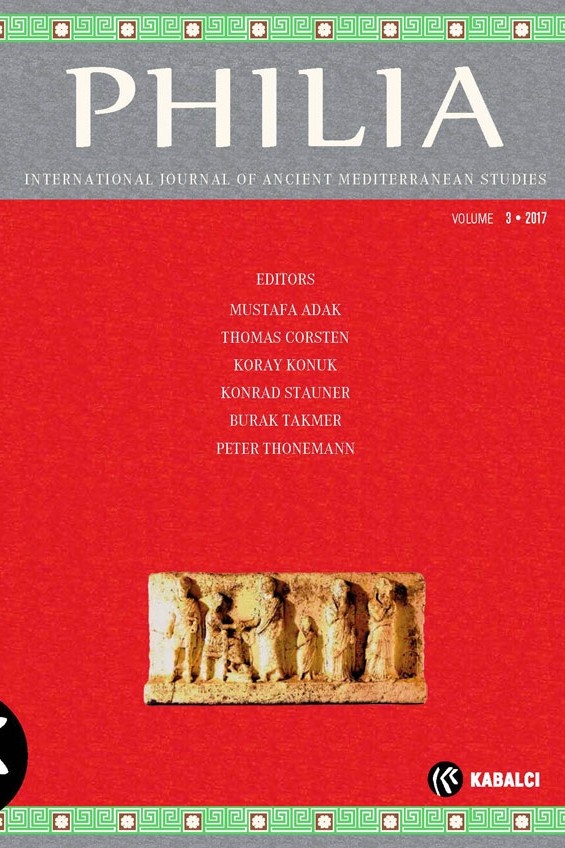Sardeis Sinagog’u Yazıtları Üzerine Kısa bir Epigrafik İnceleme
Makalede Sardeis Sinagog’unda bulunmuş üç adet adak
yazıtı (İ.S. 4.–6. yy.) ele alınmaktadır. Söz konusu yazıtlar defalarca
yayımlanmış olsalar da bunların okunmalarında ve anlaşılmalarında bazı düzeltme
önerilerinde bulunmak hala mümkündür. No. 1 vezinli bir yazıta ait fragmandır: Bir
(veya birden çok) kadın “çocukları ve eş(ler)i adına” binanın bir bölümünü
adamışlardır, metnin heksametron vezniyle ele geçen kısmı Quintus Smyrnaeus’tan
esinlenmiş gözükmektedir. No. 2 önceki edisyonlarda [Au]r. Kelainos şeklinde
okunan [Ma]rkell[e]inos adında birinin adak yazıtıdır. Söz konusu kişi “akrabaları
ve sütannesi [--]adia adına” kaplamaların bir bölümünü adak olarak karşılamıştır.
No. 3’te tanıtılan ve mermer zemin üzerine çiziktirilen grafito, yine önceki
edisyonlarda “Mapa(?)’nın adağı” şeklinde anlaşılmıştır. Bu haliyle anlamlı
bir transkripsiyonu yapılamayan metnin ilk harfi gerçekte Μ değil, Λ’dır. Böylece söz konusu
adağın Lapas adından biri tarafından yapıldığı anlaşılmaktadır. Bu isim, “dille
yalayarak içmek” anlamına gelen λάπτω fiilinden türetilmiştir ve muhtemelen bu lakabı
taşıyan kişinin içkiye karşı pek de yatkın olmadığına göndermede
bulunmaktadır.
Anahtar Kelimeler:
Sardeis, Yahudi toplulukları, Quintus Smyrnaeus, yazıtlar, Lapas
Epigraphische Kleinarbeit. Zu Inschriften der Synagoge von Sardeis
The epigraphical part of the contribution deals
with three votive inscriptions (4th-6th cent.) found in the synagogue of Sardis,
they have been published several times but their reading and understanding can
be improved: No. 1 is the fragment of a verse inscription (the only one of this
group of dedications): A lady (or several ladies) offered a part of the
building “on behalf of the children and the husband(s)”, the preserved rest of
the hexameter seems to be inspired by the Posthomerica of Quintus Smyrnaeus.
No. 2 is the dedicatory inscription of a [Ma]rkell[e]inos (former reading: [Au]r.
Kelainos), he had given a portion of the marble revetment as ex-voto “on behalf
of his relatives and [- -]adia, his nurse” (the latter word had not been
understood from the preserved letters). The graffito no. 3, scratched into the
marble floor, had been understood as “Vow of Mapa(?)”, the first letter of the
enigmatic MAPA is in fact a Lambda. The vow had thus been made by a man called Lapâs,
a name attested elsewhere, derived from the verb laptô, “lap with the tongue,
drink greedily”, probably an allusion to a weak spot of its bearer.
Keywords:
Sardeis, Jewish community, Quintus Smyrnaeus, inscriptions, Lapas,
___
- Bernand 1992 A. Bernand, La prose sur pierre dans l’Égypte hellénistique et romaine. Tome I: Textes et traductions. Tome II: Commentaires, Paris 1992.
- Herrmann 1997 P. Herrmann, Discours de clôture, in: M. Christol – O. Masson (Hrsgg.), Actes du Xe Congrès International d’Épigraphie grecque et latine. Nîmes, 4–9 octobre 1992, Paris 1997, 489–496.
- Feissel 2002 D. Feissel, Inscriptions Chrétiennes et Byzantines, BE 115, 2002, 757–777.
- Kroll 2001 J. H. Kroll, The Greek Inscriptions of the Sardis Synagogue, Harvard Theo¬logical Review 94, 2001, 5–127.
- Robert 1963 L. Robert, Noms indigènes dans l'Asie Mineure gréco-romaine, Paris 1963.
- Robert 1964 L. Robert, Nouvelles inscriptions de Sardes I: Décret hellénistique de Sardes, Dédicaces aux dieux indigènes, Inscriptions de la synagogue, Paris 1964.
- Schwyzer 1959 E. Schwyzer, Griechische Grammatik I3, München 1959.
- Seager – Kraabel 1983 A. R. Seager – A. T. Kraabel, The Synagogue and the Jewish Community, in: G. M. A. Hanfmann (Hrsg.), Sardis from Prehistoric to Roman Times: Re¬sults of the Archaeological Exploration of Sardis 1958–1975, Cambridge, Massachusetts – London 1983, 168–190, 281–285.
- Wackernagel 1904 J. Wackernagel, Studien zum griechischen Perfektum, Göttingen 1904.
- Wilhelm 1946 A. Wilhelm, ΑΙΓΥΠΤΙΑΚΑ, Sitzungsberichte der Kaiserlichen Akademie der Wissenschaften in Wien, Phil.-hist. Kl. 224,1, Wien 1946.
- ISSN: 2149-505X
- Başlangıç: 2015
- Yayıncı: Kabalcı Yayıncılık
Sayıdaki Diğer Makaleler
Demetrias Kenti’nde İmparator Kültü, Yunan Tanrılar ve Toplumsal Yapı
Apollonia ad Rhyndacum’dan Yeni Yazıtlar
Antik Dönem’de Orman Yangınlarının Önemine Dair
Antinoupolis Kenti’nden bir Ephebos Listesi’ne ait Yeni bir Fragman
Lucio DEL CORSO, Rosario PİNTAUDİ
Harpaliani. Roma Kolonisi Philippi’de Yeni Bir Köy
Leto, Kurbağalar vb. Hakkında. Versay ve Hattuşa Arasındaki Bağlantılar
Serdica Konsili M.S. 343: Doğu ve Batı Kiliselerinin Yol Ayrımı Mı?
Portulanlar ve Portulan Haritaları Işığında Hellespontos ve Bithynia Sahilleri
Herakleia Pontike’li Historiograflar ve Eserleri
